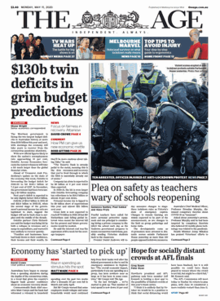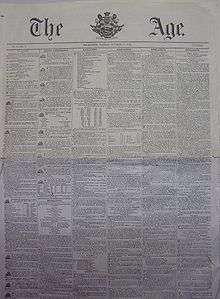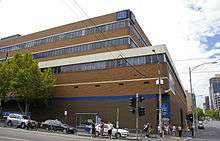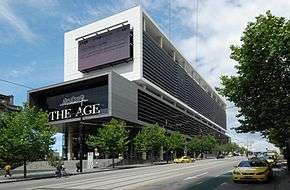The Age
The Age is a daily newspaper in Melbourne, Victoria, Australia, that has been published since 1854. Owned and published by Nine, The Age primarily serves Victoria, but copies also sell in Tasmania, the Australian Capital Territory and border regions of South Australia and southern New South Wales. It is delivered both in print and digital formats. The newspaper shares some articles with its sister newspaper The Sydney Morning Herald.
 Front page of The Age (11 May 2020), highlighting various reports regarding the COVID-19 pandemic | |
| Type | Daily newspaper |
|---|---|
| Format | Compact |
| Owner(s) | Nine Entertainment Co. |
| Editor | Michelle Griffin |
| Founded | 17 October 1854 |
| Headquarters | Melbourne, Victoria, Australia |
| Readership | Total 5.321 million, Digital 4.849 million, Print 1.198 million (EMMA, March 2020) |
| ISSN | 0312-6307 |
| Website | theage.com.au |
As of March 2020, The Age had a monthly readership of 5.321 million.[1]
History
The Age was founded by three Melbourne businessmen, brothers John and Henry Cooke, who had arrived from New Zealand in the 1840s, and Walter Powell. The first edition appeared on 17 October 1854.
Syme family
The venture was not initially a success, and in June 1856 the Cookes sold the paper to Ebenezer Syme, a Scottish-born businessman, and James McEwan, an ironmonger and founder of McEwans & Co, for 2,000 pounds at auction. The first edition under the new owners was on 17 June 1856. From its foundation the paper was self-consciously liberal in its politics: "aiming at a wide extension of the rights of free citizenship and a full development of representative institutions", and supporting "the removal of all restrictions upon freedom of commerce, freedom of religion and—to the utmost extent that is compatible with public morality—upon freedom of personal action."[2]
Ebenezer Syme was elected to the Victorian Legislative Assembly shortly after buying The Age, and his brother David Syme soon came to dominate the paper, editorially and managerially. When Ebenezer died in 1860, David became editor-in-chief, a position he retained until his death in 1908, although a succession of editors did the day-to-day editorial work.
In 1882, The Age published an eight-part series written by journalist and future physician George E. Morrison, who had sailed, undercover, for the New Hebrides, while posing as crew of the brigantine slave ship, Lavinia, as it made cargo of Kanakas. By October, the series was also being published in The Age's weekly companion magazine, the Leader. "A Cruise in a Queensland Slaver. By a Medical Student" was written in a tone of wonder, expressing "only the mildest criticism"; six months later, Morrison "revised his original assessment", describing details of the schooner's blackbirding operation, and sharply denouncing the slave trade in Queensland. His articles, letters to the editor, and newspaper's editorials, led to expanded government intervention.[3]
In 1891, Syme bought out Ebenezer's heirs and McEwan's and became sole proprietor. He built up The Age into Victoria's leading newspaper. In circulation, it soon overtook its rivals The Herald and The Argus, and by 1890 it was selling 100,000 copies a day, making it one of the world's most successful newspapers.

Under Syme's control The Age exercised enormous political power in Victoria. It supported liberal politicians such as Graham Berry, George Higinbotham and George Turner, and other leading liberals such as Alfred Deakin and Charles Pearson furthered their careers as The Age journalists. Syme was originally a free trader, but converted to protectionism through his belief that Victoria needed to develop its manufacturing industries behind tariff barriers. During the 1890s The Age was a leading supporter of Australian federation and of the White Australia policy.
After David Syme's death, the paper remained in the hands of his three sons, with his eldest son Herbert becoming general manager until his death in 1939.
David Syme's will prevented the sale of any equity in the paper during his sons' lifetimes, an arrangement designed to protect family control, but which had the unintended consequence of starving the paper of investment capital for 40 years.
Under the management of Sir Geoffrey Syme (1908–42), and his editors, Gottlieb Schuler and Harold Campbell, The Age was unable to modernise, and gradually lost market share to The Argus and the tabloid The Sun News-Pictorial, with only its classified advertisement sections keeping the paper profitable. By the 1940s, the paper's circulation was lower than it had been in 1900, and its political influence had also declined. Although it remained more liberal than the extremely conservative Argus, it lost much of its distinct political identity.
The historian Sybil Nolan writes: "Accounts of The Age in these years generally suggest that the paper was second-rate, outdated in both its outlook and appearance. Walker described a newspaper which had fallen asleep in the embrace of the Liberal Party; "querulous", "doddery" and "turgid" are some of the epithets applied by other journalists. It is inevitably criticised not only for its increasing conservatism, but for its failure to keep pace with innovations in layout and editorial technique so dramatically demonstrated in papers like The Sun News-Pictorial and The Herald."
In 1942, David Syme's last surviving son, Oswald, took over the paper, and began to modernise the paper's appearance and standards of news coverage, removing classified advertisements from the front page and introducing photographs long after other papers had done so.
In 1948, after realising the paper needed outside capital, Oswald persuaded the courts to overturn his father's will and floated David Syme and Co. as a public company, selling 400,000 pounds' worth of shares. This sale enabled a badly needed technical upgrade of the newspaper's antiquated production machinery, and defeated a takeover attempt by the Fairfax family, publishers of The Sydney Morning Herald.
This new lease on life allowed The Age to recover commercially, and in 1957 it received a great boost when The Argus, after twenty years of financial losses, ceased publication.
1960–present

Oswald Syme retired in 1964 and his grandson Ranald Macdonald was appointed managing director at the age of 26 and Two years later he appointed Graham Perkin as editor. in order to ensure that the 36-year-old Perkin was free of board influence, Macdonald took on the role of editor-in-chief, a position he held until 1970. Together they radically changed the paper's format and shifted its editorial line from rather conservative liberalism to a new "left liberalism" characterised by attention to issues such as race, gender, the disabled and the environment, as well as opposition to White Australia and the death penalty.
It also became more supportive of the Australian Labor Party after years of having usually supported the Coalition. The Liberal Premier of Victoria, Henry Bolte, subsequently called The Age "that pinko rag" in a view conservatives have maintained ever since. Former editor Michael Gawenda in his book American Notebook wrote that the "default position of most journalists at The Age was on the political Left."[4] In 1966, the Syme family shareholders joined with Fairfax to create a 50/50 voting partnership which guaranteed editorial independence and forestalled takeover moves from newspaper proprietors in Australia and overseas. This lasted for 17 years, until Fairfax bought controlling interest in 1972.
Perkin's editorship coincided with Gough Whitlam's reforms of the Labor Party, and The Age became a key supporter of the Whitlam government, which came to power in 1972. Contrary to subsequent mythology, however, The Age was not an uncritical supporter of Whitlam, and played a leading role in exposing the Loans Affair, one of the scandals which contributed to the demise of the Whitlam government. It was one of many papers to call for Whitlam's resignation on 15 October 1975. Its editorial that day, "Go now, go decently", began, "We will say it straight, and clear, and at once. The Whitlam Government has run its course." It would be Perkin's last editorial; he died the next day.
After Perkin's death, The Age returned to a more moderate liberal position. While it criticised Whitlam's dismissal later that year, it supported Malcolm Fraser's Liberal government in its early years. However, after 1980 it became increasingly critical and was a leading supporter of Bob Hawke's reforming government after 1983. But from the 1970s, the political influence of The Age, as with other broadsheet newspapers, derived less from what it said in its editorial columns (which relatively few people read) than from the opinions expressed by journalists, cartoonists, feature writers and guest columnists. The Age has always kept a stable of leading editorial cartoonists, notably Les Tanner, Bruce Petty, Ron Tandberg and Michael Leunig.
In 1983, Fairfax bought out the remaining shares in David Syme and Co., which became a subsidiary of John Fairfax and Co.[5] Macdonald was criticised by some members of the Syme family (who nevertheless accepted Fairfax's generous offer for their shares), but he argued that The Age was a natural partner for Fairfax's flagship property, The Sydney Morning Herald. He believed the greater resources of the Fairfax group would enable The Age to remain competitive. By the mid-1960s a new competitor had appeared in Rupert Murdoch's national daily The Australian, which was first published on 15 July 1964. In 1999 David Syme and Co. became The Age Company Ltd, finally ending the Syme connection.


The Age was published from offices in Collins Street until 1969, when it moved to 250 Spencer Street (hence the nickname "The Spencer Street Soviet" favoured by some critics). In 2003, The Age opened a new printing centre at Tullamarine. The Headquarters moved again in 2009 to Collins Street opposite Southern Cross station. Since acquisition by Nine, the headquarters was moved to 717 Bourke St, Docklands, Melbourne, Victoria, which is also tenanted by Nine.
In 2004, Gawenda was succeeded as editor by British journalist Andrew Jaspan. Jaspan aroused controversy by initially appearing to not know that The Age was published in Melbourne, sacking conservative columnist Gerard Henderson from the paper, and by making remarks critical of Douglas Wood, an Australian engineer who was held hostage and tortured in Iraq. Jaspan accused Wood on ABC radio of being boorish and coarse for speaking harshly about those who kidnapped and tortured him.[6]
In February 2007, The Age publicly advocated on behalf of the Free David Hicks campaign (when Hicks was a prisoner at Guantanamo Bay).[7][8][9]
In 2009, The Age suspended its columnist Michael Backman after one of his columns condemned Israeli tourists as greedy and badly behaved, prompting criticism that he was anti-semitic. A Press Council complaint against The Age for its handling of the complaints against Backman was dismissed.[10]
Reporting on 19 March 2010 on alleged corruption in religion, The Age claimed that the Vienna Boys Choir "has been caught up in accusations that pedophile priests systematically abused their choristers", even though the complaints were made against teachers and older pupils of the choir, which is a private organisation.[11] Reviewing the matter, journalist Paul Mees in Crikey accused The Age of outright "fabrication".[12]
In 2014 The Age put a photograph of an innocent man, Abu Bakar Alam, on the front page, mistakenly identifying him as the perpetrator of the 2014 Endeavour Hills stabbings. As part of the settlement the newspaper donated $20,000 towards building a mosque in nearby Doveton.[13]
As of 2012, three editions of The Age are printed nightly: the NAA edition, for interstate and country Victorian readers, the MEA edition, for metropolitan areas and a final late metropolitan edition, the THA.
Like its Fairfax stablemate The Sydney Morning Herald, The Age announced in early 2007 that it would be moving from a broadsheet format to the smaller Berliner size, in the footsteps of The Guardian and The Courier-Mail.[14]
In December 2016, editor-in-chief Mark Forbes was stood down from his position pending the result of a sexual harassment investigation.[15]
The executive editor is James Chessell and the editor is Michelle Griffin. Tory Maguire is national editor, Monique Farmer life editor and the publisher is chief digital and publishing officer Chris Janz.
Headquarters
The Age's purpose-built former headquarters, named Media House, was located at 655 Collins St, Docklands, Melbourne, Victoria. After acquisition by Nine, The Age moved to 717 Bourke St, Docklands, Melbourne, Victoria to be co-located with their new owners.[16]
Masthead
The Age's masthead has received a number of updates since 1854. The most recent update to the design was made in 2002. The current masthead features a stylised version of the royal coat of arms of the United Kingdom and "The Age" in Electra bold type. The coat of arms features the French motto Dieu et mon droit ("God and my right"). According to The Age's art director, Bill Farr: "No one knows why they picked the royal crest. But I guess we were a colony at the time, and to be seen to be linked with the Empire would be a positive thing." The original 1854 masthead included the Colony of Victoria crest. In 1856, that crest was removed and in 1861, the royal coat of arms was introduced. This was changed again in 1967, with the shield and decoration altered and the lion crowned. In 1971, a bold typeface was introduced and the crest shield rounded and less ornate. In 1997, the masthead was stacked and contained in a blue box (with the logo in white). In 2002, in conjunction with an overall revamp of the paper, the masthead was redesigned in its present form.[17]
Ownership
In 1972, John Fairfax Holdings bought a majority of David Syme's shares, and in 1983 bought out all the remaining shares.
On 26 July 2018, Nine Entertainment Co. and Fairfax Media, the parent company of The Age, announced they agreed on terms for a merger between the two companies to become Australia's largest media company. Nine shareholders will own 51.1 per cent of the combined entity, and Fairfax shareholders will own 48.9 per cent.
Printing
The Age was published from its office in Collins Street until 1969, when the newspaper moved to 250 Spencer Street. In July 2003, the $220 million five-storey Age Print Centre was opened at Tullamarine.[18] The Centre produced a wide range of publications for both Fairfax and commercial clients. Among its stable of daily print publications are The Age, The Australian Financial Review and the Bendigo Advertiser. The building was sold in 2014, and printing was to be transferred to "regional presses".[19]
Editorial
The Age believes in "economic and social progress, in liberty and justice, in equity and compassion, and openness of government. We believe the role of government is to build a strong, fair nation for future generations, and not to pander to sectional interests."[20]
Editors
| Owner(s) / Management | Editor(s) / Editor-in-chief |
Year appointed | Year ended | Years as editor |
|---|---|---|---|---|
| John Cooke, Henry Cooke, and Walter Powell | T. L. Bright and David Blair | 1854 | 1856 | 2 years |
| Ebenezer Syme and James McEwan | Ebenezer Syme | 1856 | 1860 | 4 years |
| David Syme | George Smith | 1860 | 1867 | 7 years |
| James Harrison | 1867 | 1872 | 5 years | |
| Arthur Windsor | 1872 | 1900 | 28 years | |
| Gottlieb Schuler | 1900 | 1908 | 8 years | |
| Sir Geoffrey Syme | Gottlieb Schuler | 1908 | 1926 | 16 years |
| Len Briggs | 1926 | 1939 | 13 years | |
| Harold Campbell | 1939 | 1942 | 20 years | |
| Oswald Syme / David Syme and Co. | 1942 | 1959 | ||
| Keith Sinclair | 1959 | 1966 | 7 years | |
| David Syme and Co. | Graham Perkin | 1966 | 1972 | 9 years |
| John Fairfax and Sons | 1972 | 1975 | ||
| Les Carlyon | 1975 | 1976 | 1 year | |
| Greg Taylor | 1976 | 1979 | 3 years | |
| Michael Davie | 1979 | 1981 | 2 years | |
| Creighton Burns | 1981 | 1987 | 8 years | |
| Warwick Fairfax / John Fairfax Holdings | 1987 | 1989 | ||
| Mike Smith | 1989 | 1990 | 3 years | |
| John Fairfax Holdings / Conrad Black | 1990 | 1992 | ||
| Alan Kohler | 1992 | 1995 | 3 years | |
| Bruce Guthrie | 1995 | 1996 | 2 years | |
| John Fairfax Holdings | 1996 | 1997 | ||
| Michael Gawenda | 1997 | 2004 | 7 years | |
| Andrew Jaspan | 2004 | 2007 | 4 years | |
| Fairfax Media | 2007 | 2008 | ||
| Paul Ramadge | 2008 | 2012 | 4 years | |
| Andrew Holden | June 2012 | 2016 | 4 years | |
| Mark Forbes | 2016 | 2016 | 9 months | |
| Fairfax Media / Nine | Alex Lavelle | 2016 | 2020 | 3 years |
| Nine | TBC |
References
- "News media delivers record readership as news brands reach 18.2m Australians – emma data". NewsMediaWorks. 31 May 2020. Retrieved 30 July 2020.
- "The History of The Age". About us. The Age Company Ltd. 2011. Archived from the original on 9 July 2011. Retrieved 5 July 2011.
- Kroeger, Brooke (31 August 2012). Undercover Reporting: The Truth About Deception. Northwestern University Press. p. 33. ISBN 9780810163515.
- Overington, Caroline (21 July 2007). "Leunig off line: ex-editor". The Australian. News Limited. Retrieved 22 July 2007.
- "Fairfax Extends Control of David Syme and Co..,The Canberra Times, Thu 15 Sep 1983". from Trove archive, the Canberra Times.
- Bolt, Andrew (26 June 2005). "How the Left gets loonier". The Herald Sun. News Limited. Retrieved 22 July 2004.
- "Let's bring David Hicks home". The Age. 12 November 2005. Retrieved 18 January 2019.
- Debelle, Penelope (5 February 2007). "The image David Hicks' family hopes will set him free". The Age. Retrieved 18 January 2019.
- "David Hicks is no hero but the case for freeing him is just". The Age. 30 December 2007. Retrieved 18 January 2019.
- "Complaint against The Age dismissed". The Age. Fairfax Media. 26 April 2009. Retrieved 5 July 2011.
- Boyes, Roger (18 March 2010). "Vienna Boys Choir caught up in sex abuse scandals". The Times. Times Newspapers Ltd. Retrieved 5 July 2011.
- Mees, Paul (23 April 2010). "Here's a crazy idea: What if the Pope is innocent?". Crikey. Private Media Pty Limited. Retrieved 5 July 2011.
- Trounson, Andrew (3 March 2015). "Age sorry to victim of snap slip". The Australian.
- Hogan, Jesse (26 April 2007). "Fairfax flags narrower papers, job losses". The Age. Fairfax Media. Retrieved 27 April 2007.
- "Subscribe to The Australian". www.theaustralian.com.au. Retrieved 2 December 2016.
- "The Age breaks 50-years of Spencer Street". Fairfax Media. 2019. Retrieved 13 December 2019.
- Johnstone, Graeme (March 2009). "Evolution of a masthead". The Age Extra (4): 4–5. Archived from the original on 6 July 2011. Retrieved 9 June 2011.
- Johanson, Simon (19 June 2012). "Landmark printing press site to be sold". The Sydney Morning Herald. Archived from the original on 8 July 2018. Retrieved 13 August 2012.
- Johnason, Simon (23 March 2013). "Fairfax puts timeline on sale of printing presses". The Sydney Morning Herald. Archived from the original on 8 July 2018. Retrieved 25 January 2014.
- "Labor's policies best reflect our values". The Age. 5 September 2013. Retrieved 1 February 2020.
Further reading
- Merrill, John C. and Harold A. Fisher. The world's great dailies: profiles of fifty newspapers (1980) pp 44–50
- C. E. Sayers, David Syme, Cheshire 1965
- Don Hauser, The Printers of the Streets and Lanes of Melbourne (1837–1975) Nondescript Press, Melbourne 2006.
External links
- theage.com.au – The Age website
- about.theage.com.au – The Age corporate website
- inside.theage.com.au – The Age information hub
- Half a century of obscurity (Sybil Nolan on the history of The Age)
- Sir Geoffrey Syme "Sir Geoffrey Syme Journalist & Managing Editor of The Age from 1908 until 1942"
- The Age, Google news archive. —PDF files of 32,807 issues, dating from 1854 to 1989.
- The Age (Melbourne, Vic. : 1854 - 1954) at Trove